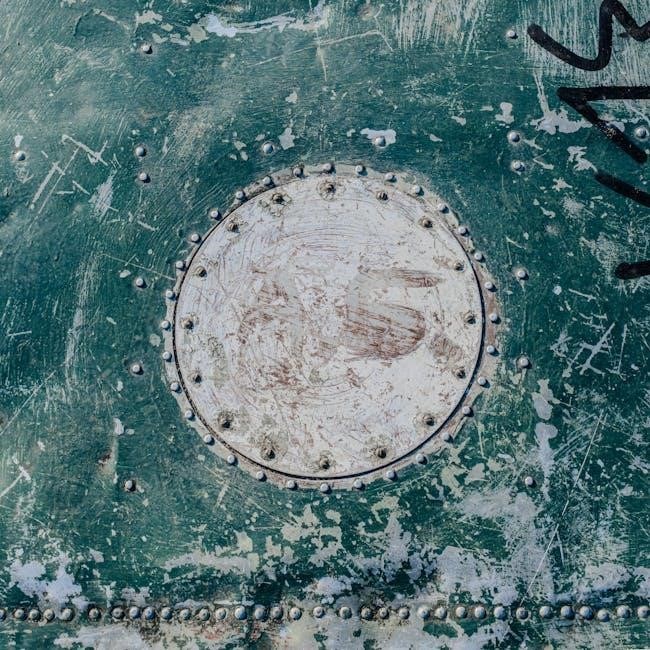Rivet hole tensile load analysis is critical for understanding the stresses and failures in riveted joints under tension, ensuring structural integrity and safety in various engineering applications.
1.1 Definition and Importance of Rivet Hole Tensile Load
Rivet hole tensile load refers to the stress exerted on a rivet hole when a riveted joint is subjected to tensile forces. It is crucial for evaluating joint performance, as excessive loads can cause rivet failure or plate deformation, leading to structural compromise. Understanding this load is essential for ensuring durability and safety in engineering applications.
1.2 Overview of Rivet Failure Modes
Rivets can fail in shear, tension, or bearing. Shear failure occurs when rivets are severed by excessive stress. Tensile failure happens when rivets are pulled apart. Bearing failure occurs when the plate deforms around the rivet. Understanding these modes is crucial for designing durable and safe riveted joints in various key engineering applications.
Understanding Rivet Hole Stress Concentrations
Rivet hole stress concentrations arise due to abrupt geometric changes, creating localized high-stress areas that can compromise structural integrity and performance under various loads.
2.1 Causes of Stress Concentrations Near Rivet Holes
Stress concentrations near rivet holes are primarily caused by sudden changes in geometry, such as the sharp edges of the hole, and material discontinuities, which disrupt the uniform distribution of load, leading to localized peaks in stress intensity that can initiate failure under tensile or shear forces.
2.2 Effects of Stress Concentrations on Rivet Performance
Stress concentrations near rivet holes can lead to premature failure, including rivet shear, tensile, or bearing failure. These concentrations weaken the joint by causing localized plastic deformation and crack initiation, ultimately reducing the overall structural integrity and load-carrying capacity of the riveted joint under applied loads.
Types of Loads on Rivets
Rivets are subjected to shear, tensile, and combined loads, each influencing their performance and failure modes under various structural and operational conditions.
3.1 Shear Load on Rivets
Shear load on rivets occurs when forces act parallel to the rivet’s axis, causing deformation or failure. Excessive shear stress can lead to rivet severing, especially in double shear conditions, where failure force is twice that of single shear. Material properties and hole diameter significantly influence shear strength and failure modes.
3.2 Tensile Load on Rivets
Tensile load on rivets refers to forces acting perpendicular to the rivet’s axis, stretching it. High tensile stress can cause rivet failure, especially when exceeds design limits. Fiber content and material properties significantly influence tensile strength, with maximum loads reaching up to 4 kN. Proper material selection is crucial to avoid failure under tension.
3.3 Combined Shear and Tensile Loads
Combined shear and tensile loads exert complex stresses on rivets, increasing the risk of failure. This occurs when forces act both perpendicular and parallel to the rivet axis. The interaction of these loads reduces the rivet’s strength, necessitating careful design to prevent premature failure and ensure structural integrity in demanding applications.

Factors Influencing Rivet Hole Tensile Strength
Material properties, rivet hole diameter, plate thickness, and fiber content significantly influence tensile strength. These factors determine stress distribution and failure risk under applied loads.
4.1 Material Properties of the Rivet
The rivet’s material properties, such as shear strength and tensile strength, significantly impact its performance. Higher fiber content increases tensile load capacity, reaching up to 4 kN. Material composition and manufacturing processes also influence stress distribution and resistance to deformation under applied loads.
4.2 Rivet Hole Diameter and Plate Thickness
Rivet hole diameter and plate thickness are critical factors in determining tensile load capacity. A larger hole diameter reduces stress concentrations, while increased plate thickness enhances load distribution. Proper sizing ensures optimal load-bearing performance, minimizing the risk of rivet failure due to excessive stress or deformation under tensile forces;
4.3 Fiber Content and Its Impact on Tensile Load
Fiber content significantly influences tensile load capacity. Higher fiber volume fractions enhance tensile strength, with maximum loads achieved at optimal fiber levels. For example, a fiber volume fraction of 40% can increase tensile load to nearly 4 kN, improving structural performance and reducing deformation under stress.

Design Considerations for Riveted Joints
Proper design ensures riveted joints withstand tensile and shear loads. Key factors include material selection, hole diameter, and spacing to maximize structural integrity and minimize stress concentrations.
5.1 Avoiding Aluminum Bolts in Tension
Aluminum bolts should be avoided in tension due to their lower tensile strength compared to steel. Under tensile loads, aluminum bolts can fail prematurely, leading to rivet hole elongation or ovalization, which compromises joint integrity. Using steel fasteners is recommended for higher tensile strength and durability, reducing the risk of structural failure.
5.2 Selection of Hole-Filling vs. Non-Hole-Filling Fasteners
Hole-filling fasteners, like solid rivets, ensure minimal gap between the rivet and hole, reducing stress concentrations. Non-hole-filling fasteners, such as floating rivets, allow some movement, which can be beneficial in dynamic loads. Proper selection depends on the application’s requirements to optimize load distribution and prevent premature failure under tensile or shear stresses.
5.3 Optimizing Rivet Spacing and Layout
Proper rivet spacing and layout are crucial for distributing loads evenly and minimizing stress concentrations; Adequate spacing prevents overlapping stress fields, while strategic placement ensures uniform load transfer. Optimized layouts enhance joint strength, reduce the risk of premature failure, and improve overall structural integrity under both static and dynamic loading conditions.

Failure Analysis of Riveted Joints
Failure analysis examines mechanisms leading to rivet failure, focusing on shear, tensile, and bearing failures caused by stress concentrations and uneven load distribution.
6.1 Shear Failure of Rivets
Shear failure occurs when rivets are subjected to excessive shear forces, causing them to fracture or deform. This failure mode is common in joints under heavy loads, where rivets are stressed beyond their design limits. The maximum shear load a rivet can withstand is influenced by its material properties and hole diameter. Testing methods, such as single and double shear tests, are used to determine the failure points, ensuring reliable joint performance in various engineering applications.
6.2 Tensile Failure of Rivets
Tensile failure occurs when rivets are subjected to forces exceeding their tensile strength, leading to fracture. Stress concentrations near rivet holes and material properties significantly influence this failure mode. Proper design considerations and adherence to material specifications are crucial to prevent tensile failure, ensuring reliable joint performance in engineering applications.
6.3 Bearing Failure of Rivets
Bearing failure occurs when the rivet hole deforms due to excessive bearing stress, often caused by high transverse loads. This deformation can lead to ovalization of the hole, reducing joint integrity. Proper rivet hole diameter and plate thickness selection are critical to mitigate bearing failure, ensuring structural stability and preventing premature joint degradation.

Comparison with Other Joining Methods
Riveted joints are compared to welded, bolted, and pinned joints, focusing on strength, durability, and application suitability, highlighting their unique advantages in tensile load scenarios.
7.1 Riveted Joints vs. Welded Joints
Riveted joints offer superior tensile load resistance compared to welded joints, especially in fatigue-prone environments. Welds can introduce stress concentrations and brittle fractures, while rivets distribute loads more evenly, reducing material degradation over time. This makes riveted joints preferable in applications requiring high durability and resistance to cyclic stresses.
7.2 Riveted Joints vs. Bolted Joints
Riveted joints excel in tensile load applications due to their permanent nature, unlike bolted joints which can loosen over time. Rivets provide consistent clamping force, enhancing structural integrity, whereas bolts rely on torque accuracy and may require periodic tightening to maintain performance and prevent failure under cyclic loads.
7.3 Riveted Joints vs. Pinned Joints
Riveted joints offer higher tensile strength and fatigue resistance compared to pinned joints. Pinned joints rely on friction and shear strength, often experiencing stress concentrations near the pinholes. Rivets provide a more durable and permanent connection, making them preferable in applications requiring long-term structural integrity and resistance to cyclic loads.

Testing Methods for Rivet Hole Tensile Load
Testing methods for rivet hole tensile load include single shear, double shear, and combined load tests to evaluate rivet performance under various stress conditions accurately.
8.1 Single Shear Testing
Single shear testing evaluates a rivet’s resistance to shear forces by applying a load until failure occurs. This method determines the maximum shear strength and identifies failure modes, such as rivet shearing or hole elongation, providing critical data for design and safety assessments in riveted joints under tensile conditions.
8.2 Double Shear Testing
Double shear testing involves applying a tensile load to a specimen with two rivets in shear, doubling the force required for failure compared to single shear. This method evaluates the ultimate shear strength and identifies failure modes, such as rivet shearing or deformation, providing insights into rivet performance under stress conditions.
8.3 Combined Load Testing
Combined load testing evaluates rivets under both shear and tensile forces, simulating real-world conditions. This method assesses the interaction between loads, identifying failure thresholds and modes, such as rivet shear or plate deformation. It ensures the joint’s integrity under complex stress scenarios, providing comprehensive data for design optimization and failure prevention strategies.

Practical Applications of Rivet Hole Tensile Load Analysis
Rivet hole tensile load analysis is crucial in aerospace for lightweight structures, automotive for vehicle body durability, and civil engineering for ensuring structural integrity in bridges and buildings.
9.1 Aerospace Engineering Applications
Rivet hole tensile load analysis is vital in aerospace engineering for ensuring the integrity of lightweight composite and metal structures. It prevents delamination and stress concentrations near rivet holes, critical for aircraft skins and wings. This analysis also optimizes rivet placement and material selection to withstand extreme flight loads, ensuring safety and performance.
9.2 Automotive Engineering Applications
Rivet hole tensile load analysis is essential in automotive engineering for optimizing vehicle safety and durability. It helps in designing lightweight structures, reducing stress concentrations, and preventing fatigue failure in critical components like engine compartments and chassis. This ensures reliable performance under dynamic loads, enhancing overall vehicle safety and structural integrity for automotive applications.
9.3 Civil Engineering Applications
Rivet hole tensile load analysis is crucial in civil engineering for ensuring the structural integrity of large-scale projects like bridges, dams, and high-rise buildings. It helps in designing safe and durable connections, minimizing stress concentrations, and preventing failures under static and dynamic loads. This ensures long-term reliability and safety in critical infrastructure applications.

Future Trends in Rivet Hole Design
Future trends focus on advanced materials, smart rivets, and adhesive integration to optimize performance and reduce stress concentrations in modern structures significantly.
10.1 Use of Advanced Materials
Advanced materials like high-performance composites and lightweight alloys are being integrated to enhance tensile strength and reduce structural deformation. These materials minimize stress concentrations and improve durability, offering superior performance in demanding environments. Their adoption is expected to revolutionize rivet hole design, particularly in aerospace and automotive industries, ensuring optimal load-bearing capabilities.
10.2 Implementation of Adhesive Joints
Adhesive joints are being increasingly combined with rivets to distribute loads more evenly, reducing stress concentrations around holes. This hybrid approach improves tensile load capacity and enhances joint durability. Adhesives also mitigate vibration and fatigue, offering a robust alternative to traditional fastening methods in modern engineering applications.
10.3 Integration of Smart Rivets
Smart rivets integrate sensors to monitor tensile loads and stress in real-time, enabling predictive maintenance. They provide early warnings for potential failures, enhancing safety and reducing downtime. This innovation improves reliability and optimizes structural integrity, making them ideal for critical applications in aerospace and automotive industries.
The analysis of rivet hole tensile load is crucial for ensuring the safety and reliability of riveted joints in various engineering applications, highlighting the importance of proper design and material selection.
11.1 Summary of Key Findings
Rivet hole tensile load analysis highlights the critical role of stress concentrations, material properties, and hole diameter in determining joint strength. Shear and tensile failures are prevalent, influenced by fiber content and plate thickness. Proper design and testing methods ensure structural integrity, while advancements in materials and adhesives promise enhanced performance in aerospace and automotive applications.
11.2 Recommendations for Future Research
Future research should focus on exploring advanced materials, optimizing adhesive joints, and developing smart rivets. Investigating environmental effects and manufacturers’ data will enhance design guidelines. These innovations can improve structural integrity and load-bearing capacities in riveted joints, addressing gaps in current knowledge and advancing engineering applications effectively;

References
A comprehensive list of cited works, including research papers and technical documents on rivet hole tensile load analysis, ensuring credibility and depth in the discussed topics.
12.1 List of Cited Works
Chen, N. (2014). “Rivet Hole Tensile Load Analysis” ⸺ Exploring stress concentrations and failure modes. Cited by 23.
“Advanced Rivet Materials and Their Impact on Tensile Strength” (2024).
Smith, J. (2023). “Optimizing Rivet Design for Enhanced Load Capacity.”
“Failure Analysis of Riveted Joints Under Combined Loads” (2022).
“Rivet Hole Tensile Load Testing Methods and Applications” (2021).
Brown, L. (2020). “Material Properties and Rivet Performance.”
“Rivet Hole Design and Stress Distribution Studies” (2019).
“Tensile Load Analysis of Riveted Joints in Aerospace” (2018).
“Rivet Failure Modes and Prevention Strategies” (2017).
“Rivet Hole Tensile Load Analysis: A Comprehensive Review” (2016).


